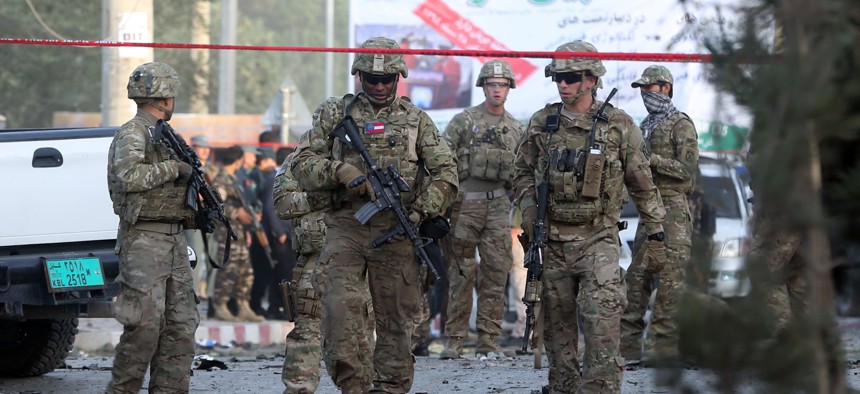
U.S. soldiers inspect the site of a suicide attack in the heart of Kabul, Afghanistan, Saturday, Aug. 22, 2015. AP Photo/Massoud Hossaini
U.S. Commander in Afghanistan: Now Is Not the Time to Leave
Gen. Campbell tells lawmakers he has sent the White House various options for keeping troops beyond 2016.
Last year, when President Barack Obama established the goal of reducing U.S. presence in Afghanistan to an embassy force by the end of 2016, the situation was very different — and now the White House is thinking about staying longer, Gen. John Campbell told the Senate Armed Services Committee today.
The 2014 decision “did not take into account the change over the last two years,” said Campbell, who leads the U.S. and NATO forces in Afghanistan. In that time, the Taliban have resurged in the north, attacking larger and larger targets like the city of Kunduz, while ISIS has moved into Khorasan province. Meanwhile, the NATO presence has shrunk to just 14,000 people, including 10,000 U.S. troops.
Campbell told lawmakers that he has given the White House a plan, containing various options and “pros and cons,” for keeping a larger force in Afghanistan beyond January 2017. The administration is considering it, the general said.
“In the past, when flexibility has been requested of [Obama], he took it under serious consideration and made his decision. He provided flexibility this year,” said Campbell of the recent White House decision to keep 10,000 troops in the country through 2016. “The same decision process is being worked through now for 2016 and beyond.”
Afghan President Ashraf Ghani, unlike his predecessor, supports such an extension as do Republican lawmakers.
Sen. Lindsey Graham, R-S.C., who is running to succeed Obama as president, used the hearing to voice his disapproval with the current White House plan. “We would be nuts to not have a counter terrorism force inside Afghanistan,” he said.
The Washington Post reports that Campbell has sent five plans to the President, at least one of which requests troop levels above 7,000. At the hearing, Campbell declined to offer specifics about his the alternative plans.
He did say that while the Afghan Security Forces were still largely unable to provide close air support and other key capabilities, other areas were improving. He cited the new integrated intelligence center.
“Afghanistan has much better [human intelligence] than I do,” he said.
At the end of August, Army Gen. Martin Dempsey, then-chairman of the Joint Chiefs of Staff, sent his own proposal to keep 3,000 to 5,000 U.S. troops in country on two or three bases, the Post reported: “The lily-pad bases would potentially house American drones and fighter jets as well as elite counterterrorism troops, and could be at Bagram air base north of Kabul and one or two other airfields, said senior administration officials who spoke on the condition of anonymity to discuss internal planning.”
The White House did not respond to requests for comment.
